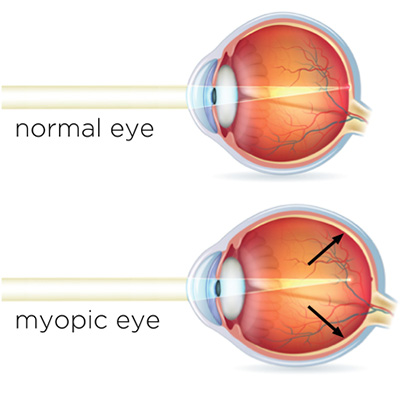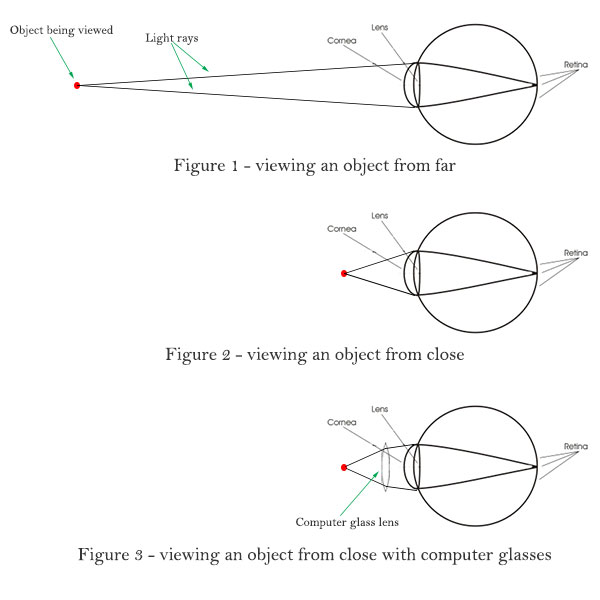Home
What is Computer Vision Syndrome (CVS)?
As our use of technology and gadgets continues to rise, our eyes are paying the price. According to the National Institute of Occupational Safety and Health, over 90% of computer and device (tablet pc, smart phones, e-book, etc.) users experience a problem so common there’s a name for it: computer vision syndrome (CVS).
Viewing a computer screen is different than reading a printed page. Often the letters on the computer screen are not as precise or sharply defined, the level of contrast of the letters to the background is reduced, and the presence of glare and reflections on the screen may make viewing difficult.
Viewing distances and angles used for computer work are also often different from those commonly used for other reading or writing tasks. As a result, the eye focusing and eye movement requirements for computer viewing can place additional demands on the visual system.
CVS is not one specific eye problem. Instead, the term encompasses a whole range of eyestrain and pain experienced by computer users. Further, it afects people of all ages, from school children to adults.
If you have computer vision syndrome, you may experience some or all of these symptoms:
- Blurred vision
- Double vision
- Dry, red eyes
- Eye irritation
- Headaches
- Neck or back pain
The extent to which individuals experience visual symptoms often depends on the level of their visual abilities and the amount of time spent looking at the computer screen.
Many of the visual symptoms experienced by computer users are only temporary and will decline after stopping computer work. However, some individuals may experience continued reduced visual abilities, such as blurred distance vision, even after stopping work at a computer. If nothing is done to address the cause of the problem, the symptoms will continue to recur and perhaps worsen with future computer use.
Some of the symptoms of CVS such as neck or back pain can be relieved by changing seating posture. Others such as dry eyes and irritation can be helped by blinking more often or using eye drops.
Computer glasses are the simplest solution for blurred distance vision resulting from computer /device use.
Why is blurred distance vision bad?
It is beyond doubt that the levels of short sightedness(myopia) in developed countries in particular are on the increase. A study in 2009 found the estimated prevalence of myopia in persons aged 12 to 54 years was significantly higher in 1999-2004 than in 1971-1972 (41.6% vs 25.0% respectively).
David Allamby, Founder of Focus Clinics, has reported a 35% increase of patients with advancing Myopia, since the launch of smartphones in 1997, and warns that worsening Myopia in young adults could increase by 50% within 10 years. The trend has led to David dubbing the condition 'Screen-Sighted'.
Many optometrists are of the view that myopia is purely caused by genetic factors. It is rediculous to think that our genetic make up has miraculously and drastically changed so much between 1971 and now. The only realistic explanation for the increase in myopia levels betwen 1971 and now is that we are doing something different now than we did back then.
The diagram shows what is going on in the myopic eye. The image is blurry because the focal point is not on the retina.

The next diagram shows what happens in the eye when looking at close and far objects. (Note the difference in the angle at which light enters the eye.)

When looking close for prolonged periods of time, the eye temporarily locks into place to make it easier to see close objects. When you then look away, your eye temporarily behaves like the myopic eye and you get blurred distance vision.
Prolonged near vision use e.g. by working at a computer, reading, playing video games is thought by many to cause the temporary blurred distance vision to become permanent.
In 2005, a petition was filed with the US FDA recommending the use of reading glasses for all near work. It makes very interesting reading for anyone interested in protecting their sight from the plague of short sightedness. It also explains the research done in this area. You can download a copy of the petition here.
What are computer glasses
Computer glasses are simply high quality reading glasses with an anti-glare filter.
Computer glasses are a cheat - they bend the light entering your eyes in a way that effectively puts the screen at a further distance from you than it really is. This is best explained in pictures.

These glasses reduce or eliminate blurred distance vision after using the computer etc. This is because as you can see the angle at which the rays of light enter the eye in figure 1 and figure 3 are very similar. It is similar to having been looking at something far all along.
Our computer glasses are coated with a very faint anti-glare coating to eliminate reflections that can cause eye strain. You should still use best practice to reduce glare by making changes to your working environment as the coating on the glasses is not designed to cut out massive amounts of glare.
Our glasses are available in a range of strengths: +0.0D to +2.5 and comply with BS EN 14139:2010 Specifications for ready-to-wear spectacles.